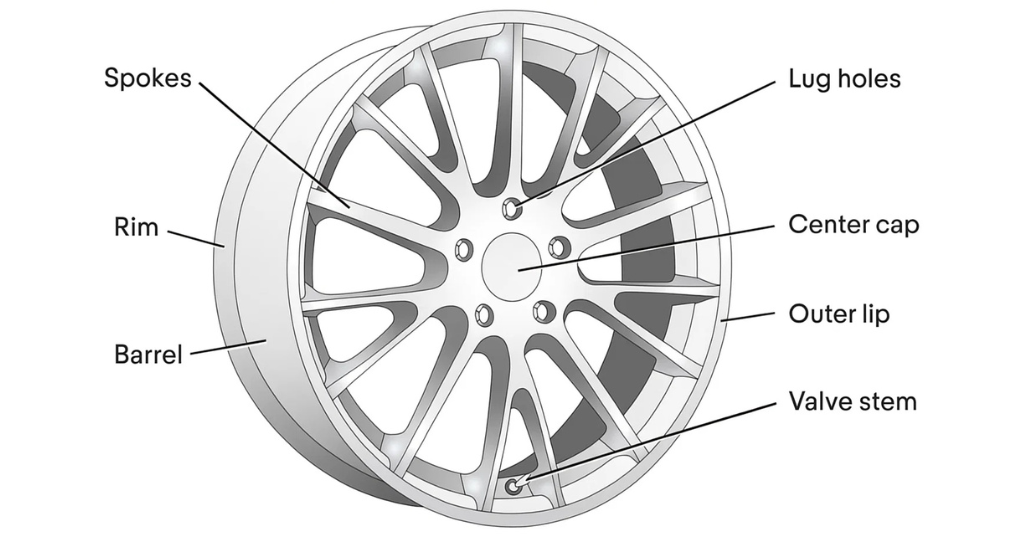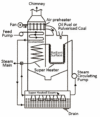Parts of Car Wheel and Their Functions
Published: 2 Nov 2025
A car wheel is more than just a circular piece of metal and rubber. It is a sophisticated assembly that plays a vital role in the vehicle’s movement, safety, and handling. Every part of a wheel, from the tire that touches the road to the center hub that connects to the axle, works together to ensure smooth driving. In this article, we’ll explore the main parts of a car wheel and their functions.

1. Wheel Bearings
Wheel bearings are essential components that allow wheels to rotate with minimal friction. They consist of an inner race, rolling elements, and an outer race. Properly functioning bearings support the vehicle’s weight, reduce wear, and ensure smooth, stable motion. Damaged bearings can lead to noise, vibrations, and unsafe driving conditions.
2. Tires
Tires are the only part of the car that directly touches the road. Made of rubber and reinforced with cords, they absorb shocks, provide traction, and transfer torque from the engine to the ground. The tread patterns on tires are designed to enhance grip and channel water away to prevent slipping, making them crucial for safety and performance.
3. Wheel Hub
The wheel hub is the center of the wheel assembly and connects the wheel to the car’s axles. It houses important components like brake discs and calipers, allowing the wheel to spin freely while supporting the car’s weight. Hubs also play a critical role in anti-lock braking systems (ABS) and traction control systems (TCS).
4. Wheel Rims
Rims are the outer edges of the wheel that hold the tire in place. Typically made of steel, aluminum, or alloy, rims support the tire, seal the air inside it, and withstand the vehicle’s weight. Custom rims not only improve wheel strength but also add style and uniqueness to a vehicle.
5. Wheel Fasteners
Wheel fasteners, such as lug nuts and studs, secure the wheel to the hub. They prevent the wheel from wobbling or detaching while driving. Ensuring that these fasteners are properly tightened is essential for safe driving, especially at high speeds or on uneven roads.
6. Valve System
The valve system, or valve stem, is responsible for inflating and deflating tires. It keeps air or nitrogen sealed inside the tire, maintaining proper pressure for safety, fuel efficiency, and smooth driving. Valve stems can be snap-in or clamp-in types, depending on the vehicle.
7. Barrel
The barrel is the main body of the wheel, located between the inner and outer rims. It provides the surface for mounting the tire and contains the drop center, which helps seat the tire properly. Flanges on the barrel prevent the tire from slipping while driving, ensuring stability and safety.
8. Flanges
Flanges are raised edges on the wheel barrel that hold the tire in place. They prevent tire slippage during acceleration, braking, and cornering. Along with lug nuts, flanges play a key role in maintaining the wheel’s secure attachment to the vehicle.
9. Center Cap
The center cap sits at the center of the wheel, covering the hub and lug holes. It protects the wheel assembly from dust, dirt, and sunlight while giving the wheel a finished, uniform look. Though not critical for functionality, a center cap enhances both the aesthetics and durability of the wheel.
10. Center Bore
The center bore is the large hole in the middle of the wheel that fits over the vehicle’s hub. A hub-centric wheel ensures proper alignment, reduces vibrations and improves stability. Accurate center bore measurements are crucial, especially when installing aftermarket wheels.
11. Lug Hole
Lug holes are openings in the wheel where lug nuts are fastened. They secure the wheel hub to the vehicle’s axle and maintain proper alignment. Proper installation of lug nuts into lug holes ensures the wheel stays safely in place during driving.
12. Bolt Circle
The bolt circle, also known as the bolt pattern, refers to the arrangement of lug holes on a wheel. It is expressed as the number of lugs by the diameter of the imaginary circle they form. The bolt circle ensures compatibility between the wheel and the vehicle’s hub.
13. Outer Lip
The outer lip is the edge of the wheel that protects the inner barrel and spokes from impact. It is most prone to damage from potholes or curbs but is also the easiest part of the wheel to repair. A strong outer lip helps maintain wheel integrity and safety.
14. Spoke
Spokes connect the hub to the rim and provide structural strength to the wheel. They distribute weight evenly and shield the wheel from minor impacts. Spokes come in a variety of designs, from simple to intricate, and influence both the wheel’s strength and appearance.
15. Beads
Beads are the reinforced edges of the tire that fit tightly against the rim. They create an airtight seal and allow efficient transfer of forces between the wheel and the tire. Damaged beads can lead to vibrations, instability, and uneven force distribution, affecting overall vehicle performance.
Conclusion
A car wheel is a complex assembly where every part, from the tire to the wheel bearings, plays a crucial role in safe and smooth driving. Understanding these components helps in proper maintenance, informing replacement decisions, and ensuring the best performance on the road. A well-maintained wheel assembly guarantees stability, safety, and a comfortable driving experience for every journey.

- Be Respectful
- Stay Relevant
- Stay Positive
- True Feedback
- Encourage Discussion
- Avoid Spamming
- No Fake News
- Don't Copy-Paste
- No Personal Attacks

- Be Respectful
- Stay Relevant
- Stay Positive
- True Feedback
- Encourage Discussion
- Avoid Spamming
- No Fake News
- Don't Copy-Paste
- No Personal Attacks



